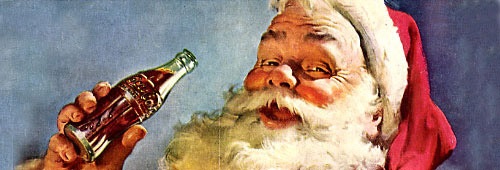Advertising and Christmas
ADText: Advertising Curriculum
Unit 8: Advertising and Christmas
 |
1. Introduction
The secular imagery of Santa Claus and the religious iconography of the Nativity coexist uncomfortably in contemporary society. On Christmas Eve celebrations in churches recall the birth of Jesus while Santa is busy elsewhere. Both the religious and the secular traditions of Christmas are generally thought to have been passed down through many generations. The story of the evolution of modern Christmas celebrations is complex, but it does reveal that some “traditions” are not so very old at all. This unit focuses on the role that advertising has played in shaping the myths and rituals of Christmas.
2. The “Traditions” of Christmas
The coming of Christmas evokes nostalgia for old-fashioned celebrations. Ask people what they mean by “old-fashioned,” and they will talk about age-old practices handed down through the generations, about families gathering to celebrate the holidays together, and about their dreams of a snowy Christmas that is free of commercialism. They may go on to talk about their own family’s special rituals, such as seeing the latest movie together, taking pictures or playing games, going for long walks in the woods, cooking and enjoying favorite foods, giving hand-made presents, singing carols, and so on. Whatever the specifics, Christmas is a time for families to celebrate and honor their traditions.
Popular stories, songs, and films have played significant roles in developing the cultural practices and beliefs that constitute the secular Christmas. Nothing has been more important than Clement Clark Moore’s A Visit from St. Nicholas (1822), also known by its first line, “’Twas the night before Christmas.” This brief story in verse spells out the myth of Santa’s visit on Christmas Eve. Another seminal text, Charles Dickens’s A Christmas Carol (1843), defines the spirit of Christmas in the values of giving, sharing, and celebrating.






